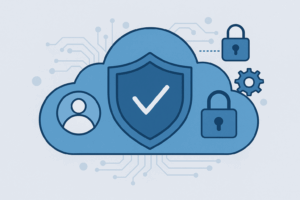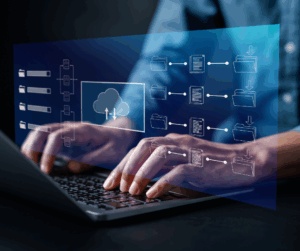In today’s digital landscape, efficient and secure Identity and Access Management (IAM) is paramount for state and local government. This article explores the significance of IAM for government agencies, focusing on strategies to modernize IAM processes and enhance cybersecurity while also providing a better constituent experience. The goal is to assist state and local governments in navigating challenges and adopting IAM solutions that streamline operations and protect sensitive data.
Understanding IAM in the Public Sector

What is Identity and Access Management?
Identity and Access Management (IAM) is a framework of policies and technologies that ensures the right individuals or entities have appropriate access to technology resources. IAM encompasses identity management and authentication, verifying the identity of a user, and access controls, which determine what resources a user can access. A comprehensive IAM system is crucial for managing digital identities effectively within an organization.
Importance of IAM for Government Agencies
For government agencies, IAM is not merely a matter of convenience; it’s a cornerstone of data security and compliance. Effective IAM solutions offer several crucial benefits:
- Protect sensitive data.
- Manage access to government services and meet stringent compliance requirements.
- Reduce the risk of unauthorized access, data breaches, and insider threats through centralized identity management and access controls.
Key Components of IAM Systems

A robust IAM system typically includes several key components. These components can be grouped into categories for easier understanding.
| Category | Components |
|---|---|
| Access Control | Role-based access controls to ensure users only have access to the resources they need. |
| User Management | A centralized directory for managing user identities. |
| Security | Multifactor authentication for enhanced security. |
| Automation | Automated provisioning and deprovisioning workflows to streamline user onboarding and offboarding processes. |
Other critical components include access governance tools for auditing and reporting.
Modernizing IAM for Local Government

Challenges Faced by Local Government Agencies
Local government agencies often face unique challenges when it comes to implementing and modernizing IAM programs. These challenges may include limited budgets, aging infrastructure, and a lack of specialized expertise. Additionally, local government agencies often struggle to balance the need for robust security with the desire to provide a seamless user experience for constituents accessing government services.
Strategies for Streamlining IAM Processes
To streamline IAM processes, local government agencies should consider several strategies. This includes centralizing identity management systems, automating provisioning and deprovisioning workflows, and implementing single sign-on (SSO) solutions to simplify access to multiple applications. Embracing cloud identity solutions can also reduce the burden on on-premises infrastructure and improve scalability, streamlining management.
Benefits of Modernizing IAM in Local Government
Modernizing IAM in local government offers several key advantages. These advantages include:
- Enhanced cybersecurity, protecting sensitive identifiable information and improving the overall security posture.
- Streamlined processes that simplify user access and improve the constituent user experience.
Additionally, automation reduces administrative overhead, empowering IT staff to focus on strategic initiatives. Ultimately, modernizing IAM allows local government agencies to deliver better government services and enhance citizen trust.
Implementing Single Sign-On Solutions

What is Single Sign-On?
Single Sign-On (SSO) is an authentication method that allows users to access multiple applications and government services after logging in only once. By centralizing the authentication process, SSO simplifies the user experience and reduces the need for users to remember multiple usernames and passwords. For state and local government agencies, implementing SSO can streamline access to various internal and external systems.
Advantages of Single Sign-On for Citizens
For citizens, the advantages of SSO are numerous. It provides a seamless and more convenient user experience when accessing government services. Citizens can access multiple services with a single set of credentials, reducing password fatigue and improving satisfaction. This can be particularly beneficial for human services portals and other platforms that require frequent authentication.
Case Studies of Successful Implementations
Several state and local government agencies have successfully implemented SSO to improve constituent access to government services. Government technology agencies can review case studies in StateTech magazine to understand the benefits of SSO for streamlining citizen access to digital services. These implementations often involve centralizing identity management and access controls to simplify the user experience.
Account and User Management in State and Local Government

Best Practices for Account Management
Effective account management is essential for maintaining cybersecurity in state and local government. Best practices include regularly auditing user accounts, enforcing strong password policies, and promptly deprovisioning accounts when employees leave. Implementing multifactor authentication adds an extra layer of security and helps protect against unauthorized access to sensitive data.
User Management Strategies for Enhanced Security
To enhance security, local government agencies should implement robust user management strategies. This includes using role-based access controls to ensure users only have access to the resources they need. Regularly reviewing and updating user permissions helps minimize the risk of insider threats and unauthorized data access. Centralize your IAM management system for better visibility.
Integrating IAM with Citizen Services
Integrating IAM with citizen services is vital for providing a secure and convenient user experience. By centralizing identity management and access controls, government agencies can streamline citizen access to various online services. This integration helps ensure that only authorized individuals can access sensitive data and government services, enhancing trust and security.
Digital Transformation in State Agencies
The Role of IAM in Digital Transformation
Digital transformation is reshaping how state and local governments operate, and IAM plays a crucial role in this evolution. As government agencies increasingly rely on digital services, robust identity and access management becomes essential for securing sensitive data and ensuring regulatory compliance requirements. Modernizing IAM programs allows government services to automate processes, enhance cybersecurity, and provide a seamless user experience for both employees and constituents.
Future Trends in IAM for Government
The future of IAM in government agencies will be shaped by several key trends. Cloud identity solutions will continue to gain traction, offering scalability and flexibility. Multifactor authentication and advanced access controls will become more prevalent to combat evolving cyber threats. Furthermore, we will observe a bigger emphasis on centralizing identity management and leveraging IAM solutions to simplify processes and strengthen the overall security posture in the public sector.
Collaboration Between Federal and Local Agencies
Collaboration between federal and local government agencies is crucial for effective IAM. Sharing best practices, threat intelligence, and resources can help state and local governments improve their cybersecurity posture. Federal initiatives can provide guidance and support to local government agencies in implementing modern IAM programs. This collaboration ensures a coordinated approach to protecting sensitive data and critical infrastructure, particularly as digital government services expand.
Conclusion

IAM for government agencies is a critical component of modern governance, requiring continuous attention and modernization. By focusing on streamlining processes, enhancing cybersecurity, and improving the constituent user experience, state and local governments can deliver more efficient and secure services. Embracing advanced IAM programs, such as single sign-on and multifactor authentication, will empower government technology to meet the evolving challenges of the digital age and provide the best service for the public sector.
